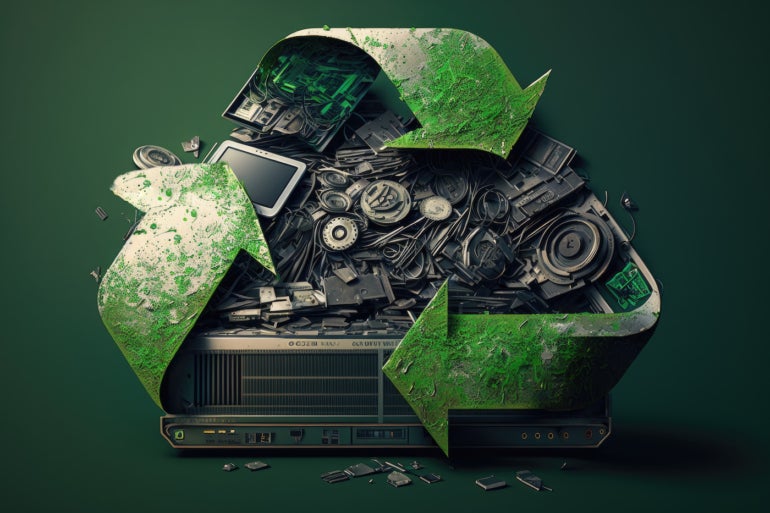Source: www.techrepublic.com – Author: Matthew Sainsbury
Australia has an e-waste problem, and for all the conversations around climate change, energy use, plastics and other ESG matters, it’s surprising that more isn’t said about it.

Currently, just 12% of the nation’s computers are recycled, and Australia is the fourth-highest generator of e-waste per capita. This a significant environmental risk, because poorly managed e-waste means heavy metals and hazardous waste such as lead, mercury, cadmium and brominated flame retardants can leak into the environment. It’s also a data leak risk if the device’s storage isn’t carefully treated.
Jump to:
The impact of e-waste goes beyond environmental damage
For Australian enterprises, e-waste is an IT life-cycle challenge, as much as an environmental one. With an increasingly decentralized workforce, IT teams are struggling to keep up with patch maintenance as well as the provisioning and deployment of new devices in such a way that it doesn’t disrupt operations.
This attempt at minimizing disruption can result in e-waste, which can incur several consequences for a business.
Data leak risk
Often, disposal of assets isn’t considered part of the operations process. This results in data leak risk. For example, in one report from earlier this year, PwC was commissioned to conduct a study on e-waste and data leak security risk. It purchased a mobile phone and tablet for $50 from a second-hand retailer.
SEE: Learn how to prevent data theft by existing and departing employees.
“They were able to retrieve 65 pieces of personally identifying information from the phone, while the tablet — which still had corporate stickers on it — contained a note with credentials for access to a database that allowed them to access 20 million sensitive PII records,” according to the report.
“It’s a far bigger problem than we realize today, than anyone has really paid attention to it in recent times,” Rob Di Pietro, PwC’s cybersecurity and digital trust leader, told NCA Newswire.
Hardware cycles are more expensive
E-waste contains valuable materials such as gold, silver, copper and rare earth metals that can be recovered through recycling. These materials are of intense value to manufacturers. Most manufacturers have recycling policies that will pay a fair market rate for old equipment that can subsidize the cost of new purchases. The difficulty in arranging recycling, however, often means organizations overlook this opportunity.
Legal and regulatory risk
There are legal and regulatory frameworks regarding e-waste management coming in Australia, including an e-stewardship regulatory framework the government committed to in 2021. Failure to stay on top of shifting regulations will expose an organization to legal risk, so businesses may need to allocate resources to develop and implement appropriate e-waste management strategies, staff training and documentation processes.
Reputational risk
Consumers expect businesses to comply with environmental, social and governance standards. While many organizations are working at improving their carbon footprint and reducing plastic waste, e-waste is an area where a lack of accountability and reporting could reflect poorly on an organization.
SEE: Discover the benefits of implementing ESG standards in your organization.
So, how did we get here?
There are several underlying reasons that contribute to Australia’s current e-waste management crisis.
Rapid technological advancement
Australia experiences a constant influx of new electronic devices as technology rapidly evolves. Most Australians replace laptops every two to four years and phones every three years. Older electronic products quickly become obsolete in this country, leading to increased e-waste generation.
High consumption rates
Australians have one of the highest electronic device ownership rates per capita globally. By 2025, statistics suggest that there will be as many as 33.8 internet-connected devices per household. Such high consumption of electronic devices contributes to a substantial volume of e-waste.
Improper disposal and recycling
An unfortunate, simple reality is that many Australians aren’t aware of the proper methods for disposing of electronic devices. Research in 2020 found that there was a “severe lack” of awareness about e-waste collection points and safe disposal. While public awareness around plastics and other sustainability measures has been pushed hard, e-waste remains a blind spot, with many simply discarding old devices in the trash.
Limited recycling infrastructure
Even when Australians are aware of e-waste, disposing of it responsibly can be difficult. While Australia has made efforts to establish e-waste recycling programs, such as the National Television and Recycling Scheme, the convenience of these systems is inadequate.
Compared to other forms of waste, in which Australians are used to having bins picked up from the doorstop on a weekly basis, e-waste recycling efforts seem more cumbersome. In addition, recycling facilities aren’t widely accessible, especially in rural areas. This leads to a lack of convenient options for individuals to properly dispose of their electronic devices.
What can be done?
It remains true that managing e-waste at scale can be a logistical challenge for organizations. The best solution would be for IT teams to work with their suppliers and partners to establish a cyclical logistics chain, where older equipment is automatically fed back to the vendor and added to their e-waste management programs using the same logistics that deliver new technology. With the right partners and suppliers, which can offer reliable data-wiping services, the IT team will be able to manage the challenges of e-waste management in Australia.
Largely due to these risk factors, the costs of poorly managing e-waste is likely to accelerate rapidly in the months ahead. Organizations that aren’t already planning to modernize their e-waste strategy will need to do so soon to avoid being caught out.
Original Post URL: https://www.techrepublic.com/article/australian-it-pros-mitigate-data-leaks-e-waste/
Category & Tags: Australia,CXO,Data Management,Security,cybersecurity,data leak,data management,e-waste,environmental social and governance,ESG,life cycle management,risk – Australia,CXO,Data Management,Security,cybersecurity,data leak,data management,e-waste,environmental social and governance,ESG,life cycle management,risk




















































